

50 Tongue Twisters to improve pronunciation in English. Tongue twisters are a great way to practice and improve pronunciation and fluency. They can also help to improve accents by using alliteration, which is the repetition of one sound. They’re not just for kids, but are also used by actors, politicians, and public speakers who want to sound clear when speaking. Below, you will find some of the most popular English tongue twisters. Say them as quickly as you can. If you can master them, you will be a much more confident speaker. Low-cost play ideas & materials. 5 ways to win over parents to the importance of play in international EYFS.
"I’m not sending my child to school for them play all day.
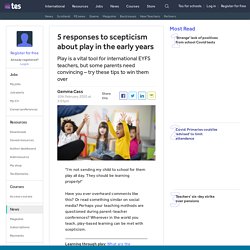
They should be learning properly! " Have you ever overheard comments like this? Assessment for Learning – Education in New Zealand. Observation, Assessment and Planning - Early Years Matters. The EYFS Profile summarises and describes children’s attainment at the end of the EYFS.
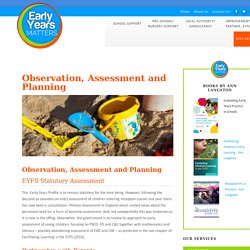
It is based on on-going observation and assessment in the three prime and four specific areas of learning, and the three learning characteristics, set out below: The prime areas of learning: Let’s lose the ADHD label and find the child. When I trained as a primary school teacher 15 years ago, these were some of the words used to describe children with ADHD: ‘Difficult.’
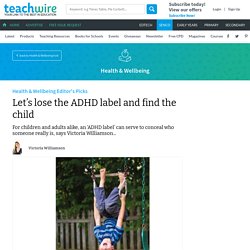
‘Challenging.’ ‘Disruptive.’ There were others, whispered by harassed-looking teachers in the staffroom or concerned parents at the school gates, but none seemed to be positive. When I got my first ‘real’ class to teach, and saw that some of the children came with the dreaded ‘ADHD’ label attached, I approached the new term with butterflies the size of dragons in my stomach. But here’s what it took me a few more years to learn… Michael wasn’t ‘difficult’ Development-Matters-FINAL-PRINT-AMENDED. The Power of Positive Adult-Child Relationships: Connection is the Key. 2Bbellybreathhome. This ‘Kindness Curriculum’ Is Free And Should Be Used In Every Classroom.
Imagine living in a world that valued kindness enough to teach it along with academics. Educators would teach kids to manage their emotions in addition to standard curriculum such as math and science. Sounds pretty amazing, doesn’t it? Well, the Center for Healthy Minds at the University of Wisconsin-Madison has created a free “kindness curriculum” for kids, designed to do just that. It’s a mindfulness-based curriculum for preschoolers that will bring kindness into the classroom. “Faced with mental and physical health challenges at a global scale, we conduct rigorous scientific research to bring new insights and tools aimed at improving the wellbeing of people of all backgrounds and ages,” states the Center’s mission statement.
21 of the Best Early Years Books for International Friendship Day. We know that skills like empathy aren’t fully developed until later in a child’s life, which is why there are so many stories on friendship and how to treat people aimed at Early Years. International Friendship Day, then, is a great opportunity to share some of these amazing books with your children. It does, however, fall on Sunday 30 July. So celebrating on the day itself is going to be difficult, doubly so for Reception classes who are on summer holidays. The Key to Effective Classroom Management. It’s a daunting but all-too-common sight for many teachers: A classroom full of rowdy students who are unable to focus on the lesson. Classroom management techniques may get things back on track, but valuable time has already been lost.
Many experienced teachers know that making meaningful connections with students is one of the most effective ways to prevent disruptions in the first place, and a new study set out to assess this approach. In classrooms where teachers used a series of techniques centered around establishing, maintaining, and restoring relationships, academic engagement increased by 33 percent and disruptive behavior decreased by 75 percent—making the time students spent in the classroom more worthwhile and productive.
“Strong teacher-student relationships have long been considered a foundational aspect of a positive school experience,” explains Clayton Cook, the lead author of the study and a professor at the University of Minnesota. Relationship reflection form. A 19-Year Study Reveals Kindergarten Students With These 2 Skills Are Twice as Likely to Obtain a College Degree (and They Have Nothing to Do With Reading) One theory all teachers with disruptive children should know about.
Imagine a classroom where children are unable to wait their turn or stay focused on their work.
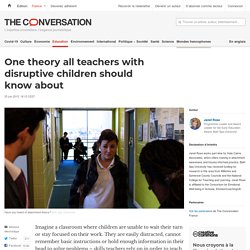
They are easily distracted, cannot remember basic instructions or hold enough information in their head to solve problems – skills teachers rely on in order to teach successfully. These behavioural issues are all examples of problems that can arise from attachment issues – based on the relationship between children and their main caregiver. Attachment theory is now one of the world’s most well-researched theories about human development. It was first proposed by the 20th-century British psychiatrist John Bowlby, who considered that children needed to develop a secure attachment with their main caregiver via sufficiently consistent, responsive, sensitive, appropriate and predictable care and support. Research has shown that secure attachments create mental processes that enable a child to regulate emotions and attune to others.
Don't Expect Toddlers To Behave Consistently — They Literally Can't. One day, when my oldest daughter was not quite 2, she wouldn’t sit still to let me change her diaper. Squirrelly and writhing, she made a game out of staying half naked. She wasn’t fussing about it or anything — in fact, she was giggling maniacally. The problem was that we were running late.
Can Free Play Prevent Depression and Anxiety In Kids? KQED Public Media for Northern CA. Babies and toddlers raised in supportive and caring home environments tended to do better on standardized tests later on, and they were more likely to attain higher degrees as adults.
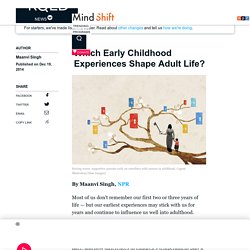
They were also more likely to get along with their peers and feel satisfied in their romantic relationships. "It seems like, at least in these early years, the parents' role is to communicate with the child and let them know, 'I'm here for you when you're upset, when you need me. And when you don't need me, I'm your cheerleader,' " says Lee Raby, a psychologist and postdoctoral researcher at the University of Delaware who led the study. Raby used data collected from 243 people who participated in the Minnesota Longitudinal Study of Risk. HowLearningHappens. HowLearningHappens. Positive Learning Environment - Primary. Background_to_the_Concept_of_Schema.
EducatorsEn. NQS_PLP_E-Newsletter_No36. Key Person & Attachment - Early Years Matters. The Key Person Children thrive from a base of loving and secure relationships.

This is normally provided by a child’s parents but it can also be provided by a key person. A key person is a named member of staff with responsibilities for a small group of children who helps those children in the group feel safe and cared for. The role is an important one and an approach set out in the EYFS which is working successfully in settings and in Reception classes. How Are Happiness and Learning Connected? As teachers, we also know that when students' affective filters or defenses are sky high, fight or flight responses will be modus operandi. A room full of defensive behaviors (withdrawn, angry) is a sad, unproductive place to teach and learn.
Now let's flip it and take a look at how much more we are able to learn when we are in harmony with the people and things in any given educational environment. Guiding Principles for Use of Technology with Early Learners. The thoughtful use of technology by parents and early educators can engage children in key skills such as play, self-expression, and computational thinking which will support later success across all academic disciplines and help maintain young children’s natural curiosity. The Departments recognize that families and early educators have many different options for using technology with early learners. The Departments believe that guidance needs to reflect the reality that families and early educators have access to apps, digital books, games, video chatting software, and a multitude of other interactive technologies that can be used with young children.
Even as new technologies emerge, the Departments believe that these principles apply, though guidance may evolve as more research on this topic is published. The Departments’ four guiding principles for use of technology with early learners are as follows: What to consider when teaching English in large classes. How many students do you teach? Do you feel that your classes are too big? Author and education consultant Jason Anderson looks at the issues and offers some potential solutions.
For many of us, our classes are larger than we would like them to be. Whole Child Development Is Undervalued. The question is how to make such an approach both systemic and sustainable. Whole Person Socio-emotional, physical, creative, and cognitive capacities are deeply intertwined and equally important in ensuring a child's wellbeing, learning, and growth. (That shouldn't be a surprise to anyone studying or supporting children's learning.) Nobel laureate James Heckman, a professor of economics at the University of Chicago, has shown that the non-cognitive skills emerging in early childhood are among the strongest predictors of adult outcomes. LearnEnglish Kids - British Council. Nursery Rhymes and Songs - BBC Teach. Music and Movement Activities for Toddlers and Preschoolers.
50+ Quick & Easy Kids Crafts that ANYONE Can Make! LearnEnglish Kids - British Council. LearnEnglish Kids - British Council. How to teach children English using illustrated storybooks. What makes illustrated storybooks such a good resource for teaching young learners of English?
The British Council’s Gail Ellis, co-author of a storytelling handbook for primary English language teachers, explains. Children-under-5-walking. Children-under-5-years. Nihms175063. Ey_making_mark_matters76708_1_ How to help your child learn English with YouTube videos.
Tracey Chapelton, education consultant and materials writer, has some advice for parents of young English learners, whose home language might not be English. Practical tips. Ten ways to support your child’s English-learning at home. Sound Words: Examples of Onomatopoeia. Onomatopoeia is a fun, linguistic tool used in literature, songs and advertisements. Now that you've seen examples of the individual words, consider the following examples of onomatopoeia words in use. Take a look at the different onomatopoeia examples in Todd Rundgren's song, appropriately named Onomatopoeia. Moodle.
Moodle. PowerfulInteractions.pdf. Moodle. Serve and Return. Effective Teacher-Child Interactions. Quality Interactions Early Years. The Brain-Changing Power of Conversation. The Science Researchers used highly faithful audio recorders — a system called Language Environment Analysis (known as LENA) — to capture every word spoken or heard by 36 4–6 year olds from various socioeconomic backgrounds over two full days.
The recordings were analyzed to measure the number of words spoken by each child, the number of words spoken to each child, and the number of conversational turns — back-and-forth exchanges initiated by either adult or child. Comparing those measurements with brain scans of the individual children, the analysis found that differences in the number of conversational turns accounted for differences in brain physiology, as well as for differences in language skills including vocabulary, grammar, and verbal reasoning.
Read the MIT News story for a fuller summary of the research. The Takeaways The “conversational turns” are key here, the researchers say. MIT Brain Study: Back-And-Forth Talk Key To Developing Kids' Verbal Skills. Carol Dweck: The power of believing that you can improve. How can parents and teachers best educate young children? What principles can both teachers and parents bring to the education of very young children? Gillian Craig, who was part of the Learning Time with Shaun and Timmy writing team, explains.
Listening Skills for Staff. A longitudinal investigation of the role of quantity and quality of child-directed speech in vocabulary development. The Power (and Peril) of Praising Your Kids. What do we make of a boy like Thomas?

Thomas (his middle name) is a fifth-grader at the highly competitive P.S. 334, the Anderson School on West 84th. Slim as they get, Thomas recently had his long sandy-blond hair cut short to look like the new James Bond (he took a photo of Daniel Craig to the barber). Ey besd. B480 Special Need Publication A4 V5 Final MR. Neurodiversity TfS online conference. Teaching English to learners with Special Educational Needs (SENs) – Myths and realities. 2Bbellybreathhome. Schema and Fairies. Schemas in Children’s Play - N a t u r e P l a y. "I Said I Want the Red Bowl!" Responding to… Does my toddler have a short attention span because she won’t sit still for a story?
NPR Choice page. The cognitive benefits of play: Effects on the learning brain. Low-cost play ideas: video. Primary school shake-up to focus on ‘play-led’ learning. Why Movement is Essential in Early Childhood. Play to Learn: Discussion. Play to Learn. Pts-why-play-is-important. Play-based-learning_statement_EN.
Learning_through_play_ey. Learning_through_play_ey. Taking Playtime Seriously. David whitebread importance of play report. Importance of play for babies & children.
How young children learn English through play. ZERO TO THREE. Teachers TV- How Do They Do It In Sweden? 6 Types of Play: How Children's Play Becomes More Social. Getting the right balance between adult-led and child-initiated learning. How do you speak 'Motherese'?
How baby brains develop. Being Multilingual: You speak with an accent. I don’t. FAQ: Raising Bilingual Children. Let's Talk. Why does my toddler love repetition? How can I help my child to start talking? (Video) Multilingual Preschoolers.